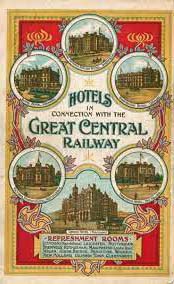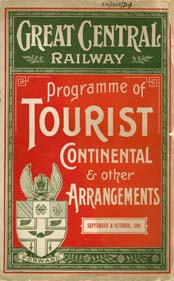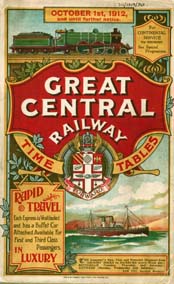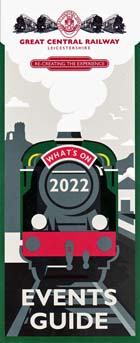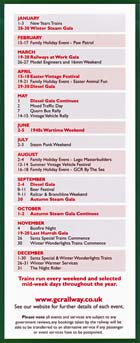 |  BIBLIOGRAPHY |
Great Central Railway's London Extension
Robert Robotham.
1999
Ian Allan Ltd.
Hardcover.
160 pages, ? cm, $86.55
In this title Robert Robotham explores in detail the stations, locomotives, and rolling stock, the operation and the atmosphere of the Great Central main line to Marlyebone.
Mac Hawkins.
2002
Grange Books.
Hardcover.
? pages, ? cm, $23.93
On 3 Sep 1966 the last main line built in Britain closed after just 67 years of operation, another victim of the Beeching axe. At the end of the last century it had been the ambition of Sir Edward Watkin to connect his series of regional railways, in the industrial heart of England, with the south coast, where a link via a Channel tunnel would provide easy access to the Continent. His dream was never fully realized and the line terminated at London, but the route did provide a fast link between Manchester and London, via Sheffield, Nottingham, Leicester, and Rugby. With the aid of photographs taken throughout the life of the Great Central Railway, this book provides a record for railway enthusiasts and anyone interested in history and the English countryside.
John Stretton.
2010
Mortons Media Group.
Paperback.
160 pages, 23.7 x 17.2 cm, $29.56
Another superb volume of photographs with interesting captions from John Stretton, this time covering the GCR from Nottingham to Rugby. Most of the book takes the usual format of past and present pictures side by side. Additionally there is a separate section covering the preservation era. The story ends at Leicester North. How sad the politicians and planners of Leicester failed to grasp the economic benefits to the region of heritage railways and safeguard the trackbed into Leicester Central. A useful full page colour coded map of the route is included. Alas, there are several slip-ups. East Leake and Whetstone stations have been omitted, the Loughborough chord is shown as "Line Closed" whereas the Knighton West to North curve which closed years ago, and is built over is shown as "Line Open". Belgrave and Birstall perhaps should have been shown as a separate closed station given that Leicester North is a new station a few yards further south. I am pleased to say that many of the photographs are good quality colour. However most photographs have been treated to a blurred border. This is presumably an artistic addition to make the whole presentation look cool. To me it has the opposite effect. The pictures have the look of prints from negatives or slides where light has got in and caused fogging.
John Quick.
2013
Lightmoor Press.
Hardcover.
136 pages, 21.5 x 27.5 cm, $79.48
J.G. Robinson was appointed locomotive superintendent of the Great Central Railway in July 1900, the year after the opening of the extension to London. This volume describes in detail the full range of liveries that were applied by the Great Central to the twenty-eight classes of passenger, freight, and mixed traffic locomotives, as well as the rail cars, that Robinson designed for the company. Chapters give a brief history of each class of locomotive and detail the changes made to their liveries over time. The book is illustrated throughout with a selection of photographs to support the descriptions in the text and supplemented with colour sample panels typical of the liveries that would have been applied in the early twentieth century.
Robin Jones.
2015
Mortons Media Group.
Paperback.
132 pages, 21.0 x 29.7 cm, $7.19
Here is the complete story of the fabled Great Central Railway, from the beginnings of the original pre-Grouping company in Victorian times to the establishment of the magnificent heritage operations at Loughborough we enjoy today, with Britain's finest steam locomotives in action along the world's only double track trunk railway in preservation. This is the first volume to feature not only today's Great Central Railway and its younger sister the Great Central Railway (Nottingham), but also all of the heritage venues that have been established on the original company's routes. There are the Buckinghamshire Railway Centre at Quainton Road, the Elsecar Heritage Railway, and a relaid privately-owned section of the Great Central main line in Oxfordshire, plus the surviving electric traction from the much-lamented trans-Pennine Woodhead Route and the Grimsby & Immingham Tramway. We take a detailed look at the locomotives and coaches that survive from the original GCR, the section that has been revived as a modern tramway in the Nottingham suburbs, and the recent calls for the former main line, the biggest victim of the Beeching closures of the Sixties, to be revived as an alternative to HS2.
Michael A Vanns.
2017
Pen and Sword Transport.
Hardcover.
128 pages, 21.59 x 28.58 cm, $41.16
This compelling book centers on the Great Central Railways early history, focusing particularly on its drive to reach London. It follows the subsequent fortunes of the London Extension right up until its closure, and into the preservation era, examining the remarkable achievements of hundreds of enthusiasts and their continuing struggle to fulfill the aspirations of those 1969 visionaries. In 1899 the Great Central Railway opened a new main line between Nottinghamshire and London. It was built to the highest of standards, civil and mechanical engineers able to benefit from the experience of over fifty years of British railway construction. It was a glorious achievement. Yet, despite incorporating some of the best facilities to enable it to operate in a more efficient way than its older rivals, it had a short working life compared to its contemporaries. By the end of the 1960s, most of it had closed. However, ironically, that abandonment by the state-owned British Railways presented an independent and enterprising group of railway enthusiasts with a unique opportunity to operate their own main line with their own engines. In 1969 the Main Line Preservation Group was formed with a vision to re-create a fully functioning, double track, steam-worked, main line between Nottingham and Leicester. This book explores the journey, development, and changes of the Great Central Railway. It is a fantastic guide to how the railway industry has changed over time.
John Evans.
2020
Amberley Publishing.
Paperback.
96 pages, 17.78 x 22.86 cm, $26.25
No railway closure in the Beeching era was mourned more than that of the Great Central Railway's main line southward from Nottingham. From its cathedral-like edifice at Victoria to the distinctive island platform stations that served towns and villages all the way to London, the Great Central touched the hearts of enthusiasts and the general public alike. This book tells the story in words and pictures of the years just before and after closure, from glorious express trains to heart-rending views as the old line was firstly abandoned and then mercilessly destroyed.
John Palmer.
2021
Pen and Sword Transport .
Hardcover.
344 pages, 22.35 x 28.19 cm, $62.59
For generations of railway enthusiasts and more lately for social historians, the life and times of the former Great Central Railway, and in particular its extension towards London in the 1890s and closure seventy years later, have generated considerable interest and controversy. Although many books have been written about the Railway, the majority in recent times have concentrated upon providing a photographic record and a nostalgic look in retrospect to what was generally perceived as happier times for the route. None of the books have presented the outcome from thorough research into the business aspects of the Railway and its successive private (LNER) and public (BR) ownerships through war and peace, and times of industrial, social, and political change, that influenced and shaped the demand for a railway service. While retaining a strong railway theme throughout, the book identifies the role played by successive governments, the electricity and coal industries, and the effect of social change that together resulted in a case for closure. The content of the book replaces much supposition with fact and places on record what really happened. The final part of the book acknowledges the fine work over half a century of volunteers dedicated to saving a section of the line in Leicestershire.
Robin Jones.
2024
Mortons Books.
Hardcover.
144 pages, 16.51 x 23.88 cm, $31.50
The Great Central Railway is the only double track preserved steam railway in the world and its main focus is on the hugely popular modern day line running between Loughborough and Leicester North. Author Robin Jones, editor of Heritage Railway Magazine, uses an incredible collection of images from Britain's top railway photographers to showcase the very best of preserved steam running in an authentic setting. History has its place too with the formation of the original Great Central Railway, built in 1899 to connect the cities of Manchester, Sheffield, and London, being explained and examined. Preservation sites set up elsewhere on the former Great Central line are also detailed including those at Buckinghamshire Railway Centre, Elsecar Heritage Railway, and Dinting Railway Centre in Glossop.
Great Central Railway
Welcome to the Great Central Railway as we celebrate 50 years since passenger trains returned to the newly preserved line in 1973. This weekend, we showcase the best that the GCR has to offer, including double-track, a superb range of locomotives and rolling stock, and impressive signaling infrastructure. A 50 wagon goods train on Saturday will be a major highlight. We have now looked after our section of line for longer than the previous three companies did individually, with the original Great Central Railway company operating the line from 1899 to 1923, followed by the London & North Eastern Railway from 1923 to 1948, and British Railways from 1948 to 1969 - 21 Jun 2023.
Thanks to your incredible support the Great Central Railway's Reunification appeal is growing all the time. After the recent Money Match March fundraising drive in March 2023, we now have £1.78 million banked and ready to spend on two further sections of the project. Watch to find out what we've done and what comes next. If you want to see more progress, please consider a donation. This is a people power project and every pound given takes us closer to success. Thank you for your support so far, you are making it happen - 11 Apr 2023.

